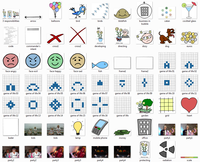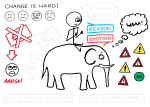…continued from part 1 and part 2. Step 7: Create slides When I am confident…
How to Make a Presentation (part 2)
…continued from part 1.
In this step I transform the topics to individual slides, by sketching on (new) sticky notes my ideas about what the slides will communicate. Sometimes it’s just a few words, sometimes just a picture, and sometimes a graph or a quote. At this point I sometimes use different colors of sticky notes to distinguish the content (the message) from the context (agenda).
Also, in this step, I try to keep the 6 SUCCES principles in mind, which tell me that sticky messages are about Simplicity, Unexpectedness, Concreteness, Credibility, Emotions, and Stories.
Step 5: Design slides
The next step is about how I will create the slides. Will I use photos? Will I use quotations? Will I make my own drawings? I write these decisions on the sticky notes so that I will remember them. I recently switched from the use of photos to (mainly) drawings, but anyone should use a format that he/she is comfortable with.
Most important for me is to understand how much work there is to do to design all slides. And whether or not I can save some time by reusing visuals across multiple slides. These are things I want to know before creating the first picture.
Then it is time to start collecting (or creating) all materials. Which for me means either browsing Flickr for free (creative commons) images, or drawing them all myself.
Here the crucial issue is consistency. I have seen many presentations with a complete lack of consistency of the visuals across the slides. But people enjoy presentations more when the design is good, and consistent. For example: if you’re using photos, you might want to make sure that the photos have a certain color as a recurring theme. Another idea is to use a metaphor (like traffic management) for most of your pictures.
p.s. Have you already ordered the book Presentation Zen, by Garr Reynolds? Why not? Didn’t I tell you this last time?
 Twitter –
Twitter –  Subscribe –
Subscribe –  Newsletter –
Newsletter –  LinkedIn –
LinkedIn –  SlideShare
SlideShare
| Latest, greatest and favoritest posts: No Maturity Models, But Individual Competence Self-Organization vs. Anarchy Great Managers Have No Secrets |







